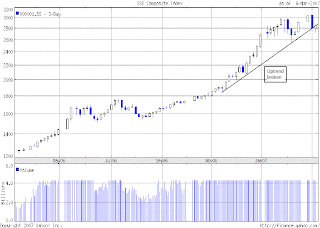New Strategy needed

Our market has re-bounded in line with other regional markets. These markets have obviously benefited from a 120-point re-bounce for Dow Jones Industrial Index overnight. Today's trading has been fairly brisk. Before we get carried away, let's look at some of the other global equity markets and their present precarious technical position.
Dow Jones Industrial Index.

London's FTSE Index.
Bombay's BSE Index.

Hang Seng index.
All the above indices have clearly broken below their uptrend line. The following indices are at their uptrend line or just tested & re-bounded from their uptrend line. This includes Shanghai's SSE Index (surprice?).

And, Nikkei 225 Index.

From the above, I believe that the worst in the global equity market may not be over yet. For those who have large position in the market, my recommendation is to reduce your position as the current re-bounce goes higher. For example, if you have a sizable position in Tenaga, you may want to use the current re-bounce to reduce your holding of Tenaga if its share price reaches RM11.70-12.00. If you manage to do so, you can buy back the same amount of Tenaga shares if its share price weakened back to its medium-term uptrend line support at RM10.20/30 (see the chart below).

Chart: Tenaga's daily chart as at March 6, 2007
Nobody is sure exactly where the market is at this moment. Here, an amusing look at one possible scenario of the next market direction.






